From Kezar to Levi’s stadiums, No. 1 49ers fan has kept the faith – and the facts

Martin Jacobs’ love affair with the San Francisco 49ers was in its infancy in 1952 when the nine-year-old entered Kezar Stadium for the first time. He still has that ticket stub and over the years has become a go-to authority on all things 49ers, a collector of team memorabilia, and the author of scores of articles and books recounting the history of the city’s favorite football team.
His Sunset District home is crammed with posters, drawings, albums, pins, emblems, banners, helmets, footballs, and uniforms. A living room couch is covered with a red and gold 49ers blanket, situated squarely in front of an extra-wide TV, where he takes in every game.
Even though he’s a hardcore fan, Jacobs stays home on game days. Watching from home, he said, avoids the long drive to Santa Clara, unpredictable weather, and the high cost of attending a game.
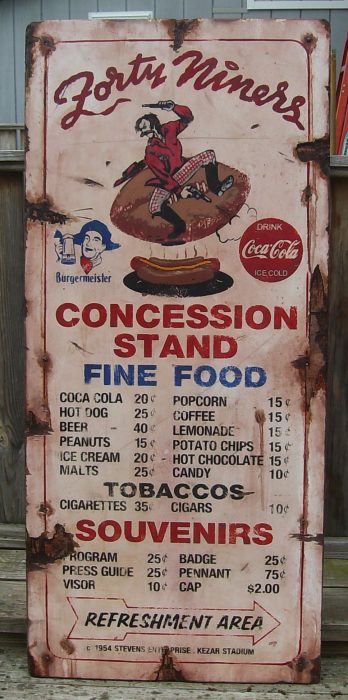
“At age 12, I saw the world in a remarkably simple way, said Jacobs, now 80. “I decided early on that there were only two types of people in the world: those who were 49ers (fans) and those who weren’t,” he said. “I didn’t know a forward pass from a lateral.”
Team historian
Jacobs was the team’s official historian for 10 years. His tenure ended after Levi’s Stadium and the 49ers’ museum were built and a curator and staff were hired to answer most questions. Jacobs still handles inquiries about the early days of the team that the staff can’t answer.
And, he’s not afraid to be a bit controversial. “Most fans think the 49ers were named after the gold rush of 1849, but not so,” he said. Jacobs said that Tony Morabito, the founding owner of the team, told him the 49ers were named after a passenger train called the “49er” he rode from Chicago to San Francisco. The story is unconfirmed and the team maintains that the popular version of the franchise’s naming is correct.
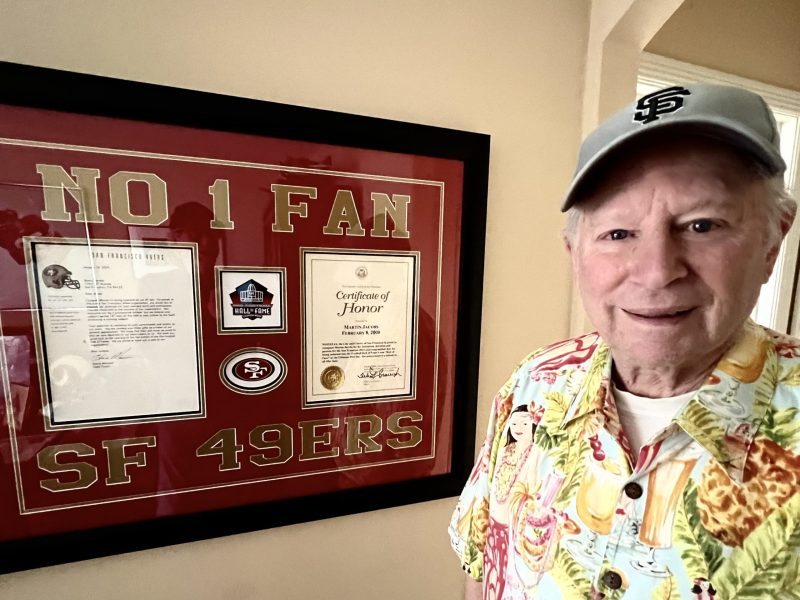
In 2000, Jacobs was named the 49ers No. 1 Fan of the Year by VISA International. A plaque of commendation from the 49ers is on display at the Pro Football Hall of Fame in Canton, Ohio.
Jacobs took a few classes in creative writing at City College of San Francisco and the University of San Francisco when he was in his early 20s. But he launched his sports writing career much earlier: “At age 13, I started writing short reviews on 49er games for the Examiner’s Sports Mailbag and the Chronicle’s Morning Muse. Anyone can write in, but my articles got published,” he said.
Journalist and author

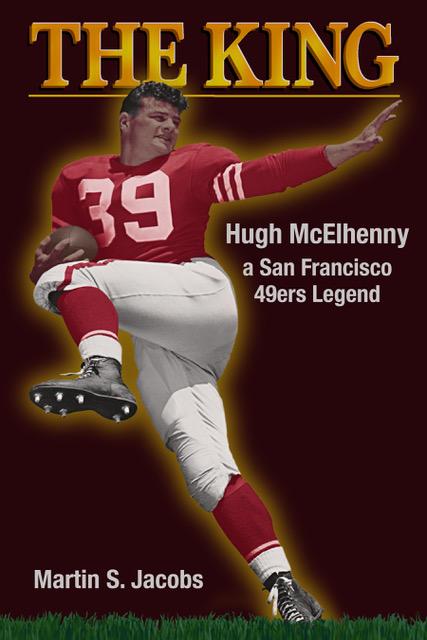
He’s the author of 10 books and is a senior contributor to Gridiron Greats magazine and other publications where he writes about football’s glory days and his other passion: World War II. Along with his 49ers collection, he has amassed a trove of thousands of homefront collectibles: posters, pins, banners, emblems, war bonds, and patriotic items that promoted the war effort.
One of his favorite stories was published in America in World II magazine. It was based on an interview with Louis Zamperini, a World War II veteran who had been a prisoner of the Japanese. Zamperini survived his imprisonment despite being starved and tortured. Zamperini’s tale was also the subject of a 2014 biography by Laura Hillenbrand that was adapted for the movie “Unbroken,” by Angelina Joie.
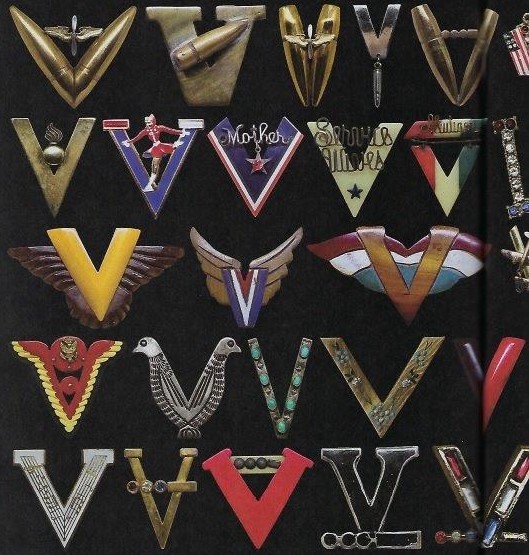
He started collecting as a teenager. “My father, a private in World War II, gave me his dog tags, a black crackle lighter, service patches, and medals he wore on his uniform. I saw collecting as a way of showing patriotism.”
Jacobs served as an Army reservist and cook at Letterman Hospital on San Francisco’s Presidio. While working there, he whetted his appetite for journalism, becoming the publisher of “The Needle,” the hospital’s bulletin.
Down to business
He also found time to open Haight Street Palace, a popular head shop located at the center of the counterculture revolution, with the help of a store manager. During this “summer of love” era, he also launched “Poster Moster,” a retail and wholesale outlet where he sold rock ‘n’ roll personality posters. The biggest sellers were Jerry Garcia of the Grateful Dead and the Jefferson Airplane, he said.
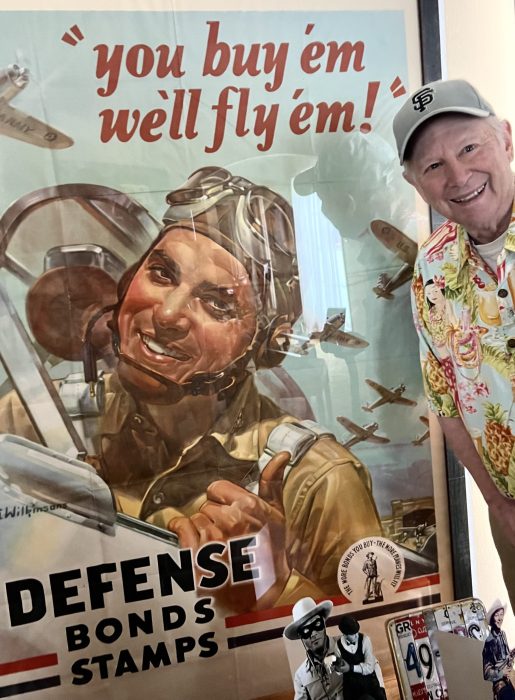
“No, I wasn’t a hippy although I dressed like one. I was somewhat of a free spirit, going to concerts. My idea was to make as much money as I could as the tourists flocked to Haight Ashbury from around the world. It was a lot of fun.”
The store got visits from George Harrison, Janis Joplin, and many others before they headlined at either the Fillmore Auditorium or Winterland dance halls.
Jacobs met his first wife, Zimra Jacobs, while she worked at the store, and the couple went on to have five children. But by 1970, he said, “the neighborhood became ugly with crime,” and he closed the shop.
In 1972, Jacobs opened a pro-sports gift shop called “Sports Stop” on Irving Street and followed that up with four more stores bearing the same name. One was in Las Vegas; he called it a sports museum and named it “Sands Hall of Fame & Gift Shop.” He also had a national mail-order business for 33 years called “Sports Locker Room.”
49ers at sea
Jacobs knew that mail order is a risky business; nearly all fail, he said. But the opportunity “to work at home, make your own hours, no bosses and make real money with very little investment,” outweighed the risk, he said. He believes he was the first to sell stadium souvenirs via mail order.
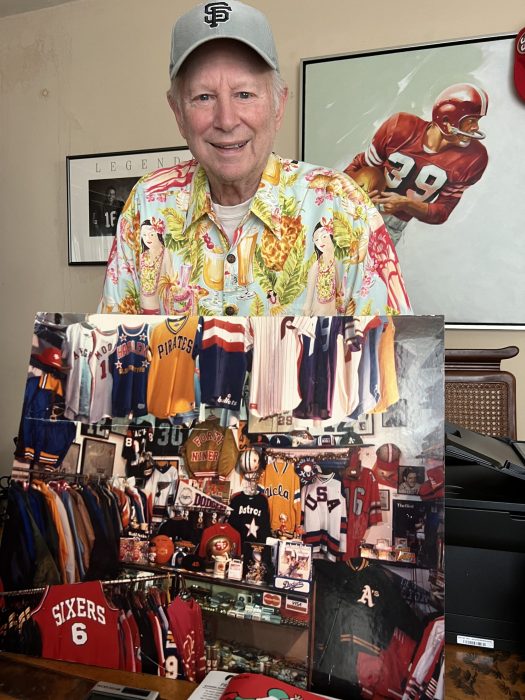
With his writing career ticking along and his elderly parents needing care, Jacobs shuttered his retail businesses in 1995. Too young to retire – he was just 52 – he continued to research and write about the 49ers.
In 2020, he published “Kezar Stadium: 49er Fans Remember.” The book recounts some of the favorite memories of fans who attended games at Kezar, the team’s first home.
As he approached 60, Jacobs, by then twice divorced, turned his attention to travel. He and an older companion traveled extensively. Together they took 66 cruises and 10 bus tours over several decades. Many of those trips were to islands in the Pacific where major battles took place during World War II. Jacobs was her caregiver at times; she passed away last year. He misses her greatly, he said.
Even without her, Jacobs is planning another voyage. “I’ll be cruising 15 days to Hawaii over Christmas and New Year’s. I’m hoping I can convince the cruise director to televise the 49ers games. If not, the ship has an internet to get the scores.”
(Jacobs said he welcomes any inquiries regarding the 49ers or questions about any of his books. You can reach him at mjacobs784@aol.com)






Craig Carrozzi
Martin is a living encyclopedia of San Francisco lore in general and 49er football in particular. I have read his book on Kezar Stadium and "The King", a biography of Hugh McElhenney, the most exciting running back in 49er history. Thoroughly enjoyed both of them.
Rob Anderson
I've been a Niner fan since the early 1950s, when they had the great backfield of Hugh McElhenny, Joe Perry, John Henry Johnson, and Y.A. Tittle. Alas, in the beginning I had to listen to games on the radio before we got a TV.
Richard C Falvey
I was at games in '46, remember the '47 team, the first real NFL game vs. the Bears Sept. 1950 taught me how football works.